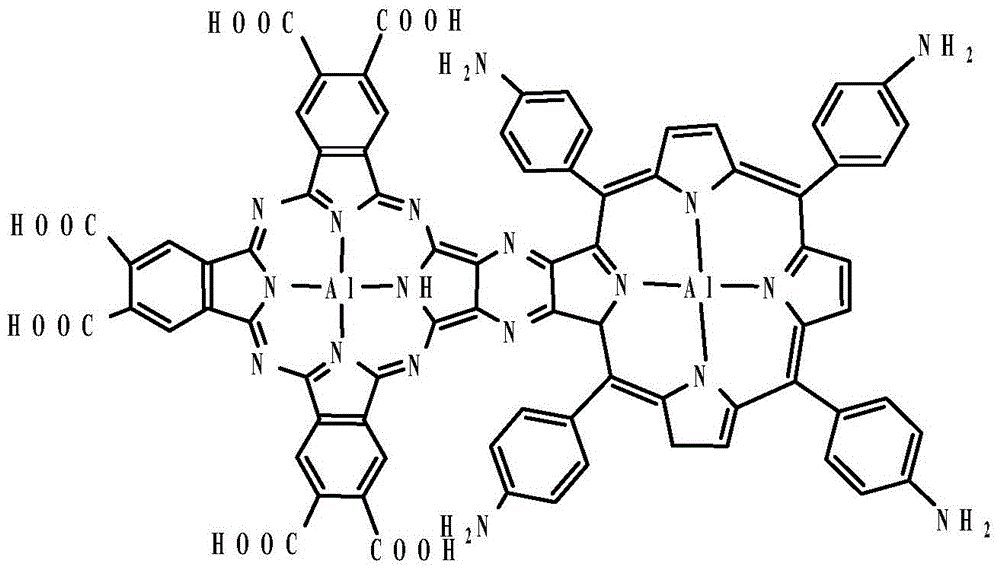Microprinting using water-soluble planar conjugated phthalocyanine porphyrin dyads as microcontact printing inks
A technology of micro-contact printing and plane conjugation, which is applied in the direction of transferring inks, inks, and household appliances from manuscripts.
- Summary
- Abstract
- Description
- Claims
- Application Information
AI Technical Summary
Problems solved by technology
Method used
Image
Examples
Embodiment 1
[0028] 1. The substrate is made of polytetrafluoroethylene, 100g of the substrate is ultrasonically cleaned with 500g of ethanol for 1 hour, then taken out, vacuum-dried at 80°C, and soaked in 500g of 5wt% γ-aminopropyltriethoxysilane ethanol After 24 hours, take it out and wash it with ethanol, then soak it in 1000 g of polyacrylic acid aqueous solution with a concentration of 1 g / L for 1 hour, take it out and dry it at 100°C.
[0029] 2. Dissolve 5,10,15,20-p-aminophenylporphyrin aluminum hexacarboxyphthalocyanine aluminum phthalocyanine in water to obtain 0.2wt% of 5,10,15,20-p-aminophenylporphyrin aluminum hexacarboxy Aluminum phthalocyanine.
[0030] 3. Soak the PDMS stamp in the aqueous solution of 5,10,15,20-p-aminophenylporphyrin aluminum hexacarboxyphthalocyanine aluminum for 30s, take it out and put it in N 2 Dry in air flow for 30s, cover the PDMS stamp coated with 5,10,15,20-p-aminophenylporphyrin aluminum hexacarboxyphthalocyanine aluminum aqueous solution on the...
Embodiment 2
[0033] 1. The substrate is made of polytetrafluoroethylene, and 100g of the substrate is ultrasonically cleaned with 700g of ethanol for 1 hour, then taken out, and vacuum-dried at 80°C. Soak the substrate in 700g of 5wt% gamma-aminopropyltriethoxysilane ethanol for 24 hours, take it out and wash it with ethanol, soak it in 1000g of polyacrylic acid aqueous solution with a concentration of 10g / L for 1 hour, take it out and dry it at 100°C.
[0034] 2. Dissolve 5,10,15,20-p-aminophenylporphyrin aluminum hexacarboxyphthalocyanine aluminum in water to obtain 5,10,15,20-p-aminophenylporphyrin aluminum hexacarboxyphthalocyanine with a concentration of 0.5 wt%. Aluminum hexacarboxyphthalocyanine.
[0035] 3. Soak the PDMS stamp in the aqueous solution of 5,10,15,20-p-aminophenylporphyrin aluminum hexacarboxyphthalocyanine aluminum for 35s, take it out and put it in N 2 Dry in airflow for 45s, cover the PDMS stamp coated with 5,10,15,20-p-aminophenylporphyrin aluminum hexacarboxypht...
Embodiment 3
[0038] 1. The substrate is made of polytetrafluoroethylene, 100g of the substrate is ultrasonically cleaned with 1000g of ethanol for 1 hour, then taken out, and vacuum-dried at 80°C. Soak the substrate in 1000g of 5wt% γ-aminopropyltriethoxysilane ethanol for 24 hours, take it out and wash it with ethanol, soak it in 1000g of polyacrylic acid aqueous solution with a concentration of 20g / L for 1 hour, take it out and dry it at 100°C.
[0039] 2. Dissolve 5,10,15,20-p-aminophenylporphyrin aluminum hexacarboxyphthalocyanine aluminum in water to obtain 5,10,15,20-p-aminophenylporphyrin aluminum hexacarboxyphthalocyanine with a concentration of 0.8wt%. Aluminum hexacarboxyphthalocyanine.
[0040] 3. Soak the PDMS stamp in the aqueous solution of 5,10,15,20-p-aminophenylporphyrin aluminum hexacarboxyphthalocyanine aluminum for 40s, take it out and put it in N 2 Dry in the air stream for 30-60s, cover the PDMS stamp coated with the aqueous solution of 5,10,15,20-p-aminophenylporphy...
PUM
| Property | Measurement | Unit |
|---|---|---|
| concentration | aaaaa | aaaaa |
| quality score | aaaaa | aaaaa |
Abstract
Description
Claims
Application Information
 Login to View More
Login to View More - R&D
- Intellectual Property
- Life Sciences
- Materials
- Tech Scout
- Unparalleled Data Quality
- Higher Quality Content
- 60% Fewer Hallucinations
Browse by: Latest US Patents, China's latest patents, Technical Efficacy Thesaurus, Application Domain, Technology Topic, Popular Technical Reports.
© 2025 PatSnap. All rights reserved.Legal|Privacy policy|Modern Slavery Act Transparency Statement|Sitemap|About US| Contact US: help@patsnap.com


